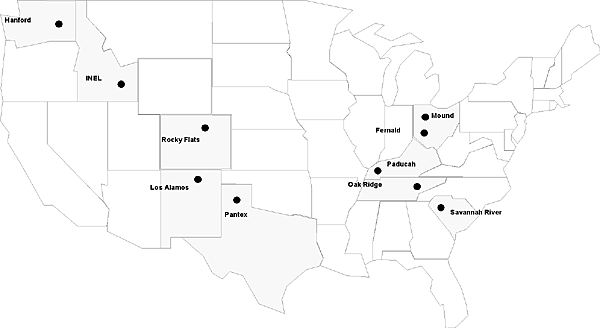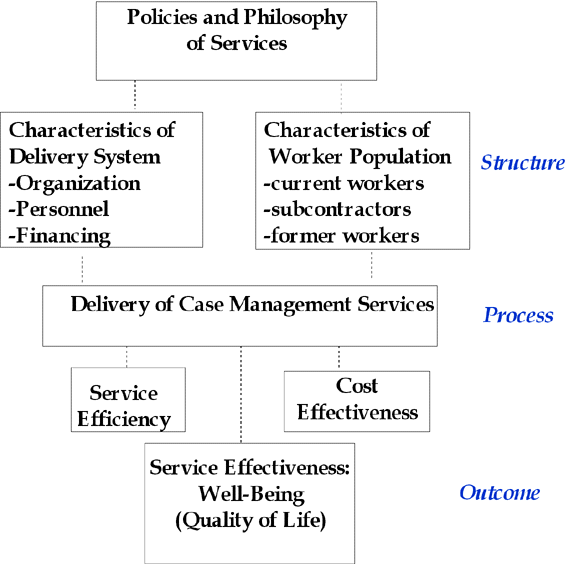Structure and Function of Occupational
Health Services at 10 DOE Sites
Mary K. Salazar, EdD, RN; Timothy K. Takaro, MD, MPH, MS;
Kathy Ertell, MS, CIH;
*Michael Gochfeld, MD, PhD;
Sally O'Neill, MN, RN;
Scott Barnhart, MD, MPH
Worker Safety and Health Task Group, University of Washington and
*University of Medicine and Dentistry of New Jersey
This research was supported by CRESP through
Department of Energy Cooperative Agreement # DE-FCO1-95EW55084.
Study Rationale
It is estimated that there are approximately 850,000 employees working throughout the US DOE complex each year— including 200,000 contractors and 650,000 subcontractors. Workers participate in a wide variety of activities that can potentially result in exposure to diverse and ill-defined hazards. Occupational health and safety services are integral to operations at most DOE sites, however, the structure and service delivery varies. Thus, it is difficult to assess and compare the occupational health and safety of site workers across the complex. The purpose of this exploratory study was to evaluate and compare the structure and function of the occupational health and safety services at selected DOE facilities in order to inform worker protection services across the complex.Specific Aims
The specific aims of the study are to describe and compare:- the primary hazards & risks associated with site activities
- the OH&S structure and philosophy of the sites
- the OH&S service delivery functions
Methods
This study involved two phases, the first included a brief written survey of occupational service providers to obtain an overview of the structure and function of the services offered at each site including an approximation of the number of site workers, the number and composition of health and safety personnel, the most prevalent hazards, the most common health and safety problems and the existing programs. The second phase consisted of in-depth phone interviews with individuals at each of the sites. Interviewees included medical directors, on-site physicians, occupational health and safety managers, and industrial hygienists.Department of Energy Study Sites

Findings
- Sites vary widely in size and worker population
- A substantial portion of workers were identified as subcontractors and are often involved in most hazardous operations
- Most frequent hazards identified: physical agents
- Highest ranked hazards by 'degree of risk': explosions and radiological exposure
- Highest ranked hazards by 'likelihood of exposure': physical agents, ergonomic
- Most common health problem: cumulative trauma disease (CTD)/ergonomic
- Most common safety problems: strains/sprains, worker attributes
- Greatest % of health professionals: health physicists
- Smallest % of health professionals: Ergonomists, MDs/PAs
- Types of H&S services offered at each site depends, in part, on the needs of the organization, and in part on the orientation and preferences of service personnel.
- Most were dissatisfied with the efficiency of efficaciousness of data management systems despite the view that they are an important means of assuring quality control and identifying areas of prevention.
- In general, OS&H service providers are housed in separate departments.
- There are many barriers to follow-up on former workers including a lack of data systems/databases that identify workers and their exposures.
Model for Evaluation of Occupational Health and Safety Services

Conclusions
- There is generally strong DOE and organizational support for effective OS&H services
- All sites offer comprehensive OS&H services however, subcontractors tend to not be included in site-OS&H programs, thus they have potential to receive inadequate OS&H coverage.
- Mismatch exists between types of risks and hazards and distribution of health professionals. The primary hazards described by participants were categorized as physical, mechanical, or chemical hazards, yet the largest proportion of service personnel provide radiation services.
- Tendency (of some) is to over-emphasize worker responsibility for health and safety.
- Physical separation of service providers and inadequate data systems compromise service efficiency and effectiveness.
- There are insufficient strategies for follow-up and monitoring of former workers who may have been exposed to hazardous substances.